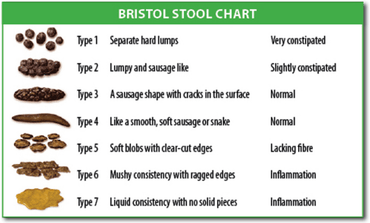Bristol stool scale

The Bristol stool scale, Bristol stool chart (BSC),[1] Bristol stool form scale, or BSF scale[2] is a medical aid designed to classify the form of human feces into seven categories. Sometimes referred to in the UK as the Meyers scale,[3] it was developed by Dr. Stephen Lewis and Dr. Ken Heaton at the University of Bristol and was first published in the Scandinavian Journal of Gastroenterology in 1997.[4] The authors of that paper concluded that the form of the stool is a useful surrogate measure of colon transit time. That conclusion has since been challenged as having limited validity, and only in types 1 and 2 when the subject is not constipated.[5] However, it remains in use as a research tool to evaluate the effectiveness of treatments for various diseases of the bowel, as well as a clinical communication aid.[6][7]
The Bristol stool scale is part of the diagnostic triad for irritable bowel syndrome: pain/discomfort (quality and quantity); bowel habit (quality and quantity); and bloating (in women).[8]
The seven types of stool are:
- Type 1: Separate hard lumps, like nuts (hard to pass)
- Type 2: Sausage-shaped, but lumpy
- Type 3: Like a sausage but with cracks on its surface
- Type 4: Like a sausage or snake, smooth and soft
- Type 5: Soft blobs with clear cut edges (passed easily)
- Type 6: Fluffy pieces with ragged edges, a mushy stool
- Type 7: Watery, no solid pieces, entirely liquid
Types 1 and 2 indicate constipation, with 3 and 4 being the ideal stools (especially the latter), as they are easy to defecate while not containing excess liquid, and 5, 6 and 7 tending towards diarrhoea.
References
- ↑ Amarenco G (2014). "Bristol Stool Chart : étude prospective et monocentrique de " l'introspection fécale " chez des sujets volontaires" [Bristol Stool Chart: Prospective and monocentric study of 'stools introspection' in healthy subjects]. Progrès en Urologie (in French). 24 (11): 708–13. doi:10.1016/j.purol.2014.06.008. PMID 25214452.
- ↑ Gut Sense What Exactly Are Normal Stools?, Konstantin Monastyrsky. Accessed July 2015
- ↑ "Meyers Scale". General Practice Notebook. Retrieved 2015-05-09.
- ↑ Lewis SJ, Heaton KW (1997). "Stool form scale as a useful guide to intestinal transit time". Scand. J. Gastroenterol. 32 (9): 920–4. doi:10.3109/00365529709011203. PMID 9299672.
- ↑ Rao SS, Camilleri M, Hasler WL, Maurer AH, Parkman HP, Saad R, Scott MS, Simren M, Soffer E, Szarka L (2011). "Evaluation of gastrointestinal transit in clinical practice: position paper of the American and European Neurogastroenterology and Motility Societies". Neurogastroenterol Motil. 23 (1): 8–23. doi:10.1111/j.1365-2982.2010.01612.x. PMID 21138500.
- ↑ Ackley, Betty J.; Ladwig, Gail B. (2013). Nursing Diagnosis Handbook, An Evidence-Based Guide to Planning Care, 10: Nursing Diagnosis Handbook. Elsevier Health Sciences. p. 240. ISBN 9780323085496.
- ↑ Bristol scale stool form. A still valid help in medical practice and clinical research G Riegler, I Esposito – Techniques in coloproctology, 2001 – Springer
- ↑ National Collaborating Centre for Nursing and Supportive Care, (UK) (February 2008). "Irritable Bowel Syndrome in Adults: Diagnosis and Management of Irritable Bowel Syndrome in Primary Care, NICE Clinical Guidelines, No. 61". PMID 21656972. Retrieved 17 November 2015.